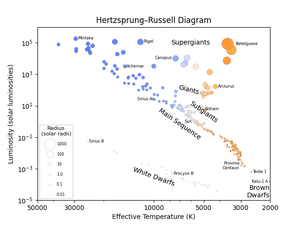Glossarbegriffe: Unterriese
Description: Ein Unterriese ist ein Stern, der auf dem Hertzsprung-Russell-Diagramm zwischen der Hauptreihe und dem Riesenast liegt. Dabei handelt es sich meist um Sterne, welche die Wasserstofffusion in ihren Kernen beendet haben und sich zu Riesensternen weiterentwickeln. Einige dieser Unterriesen pulsieren, was sie zu veränderlichen Sternen macht. Cepheiden sind ein Beispiel für eine Art von pulsationsveränderlichen Unterriesen.
Zugehörige Glossarbegriffe:
- Cepheiden
- Riesenstern
- Hertzsprung-Russell-Diagramm (HRD)
- Wasserstoffbrennen
- Hauptreihe
- Sternentwicklung
- Veränderlicher Stern
- Leuchtkraftklasse
See this term in other languages
Term and definition status: The original definition of this term in English have been approved by a research astronomer and a teacher The translation of this term and its definition is still awaiting approval
The OAE Multilingual Glossary is a project of the IAU Office of Astronomy for Education (OAE) in collaboration with the IAU Office of Astronomy Outreach (OAO). The terms and definitions were chosen, written and reviewed by a collective effort from the OAE, the OAE Centers and Nodes, the OAE National Astronomy Education Coordinators (NAECs) and other volunteers. You can find a full list of credits here. All glossary terms and their definitions are released under a Creative Commons CC BY-4.0 license and should be credited to "IAU OAE".
If you notice a factual or translation error in this glossary term or definition then please get in touch.
Related Diagrams
Hertzsprung-Russell diagram
Bildnachweis: IAU OAE/Niall Deacon
License: CC-BY-4.0 Creative Commons Namensnennung 4.0 International (CC BY 4.0) icons









